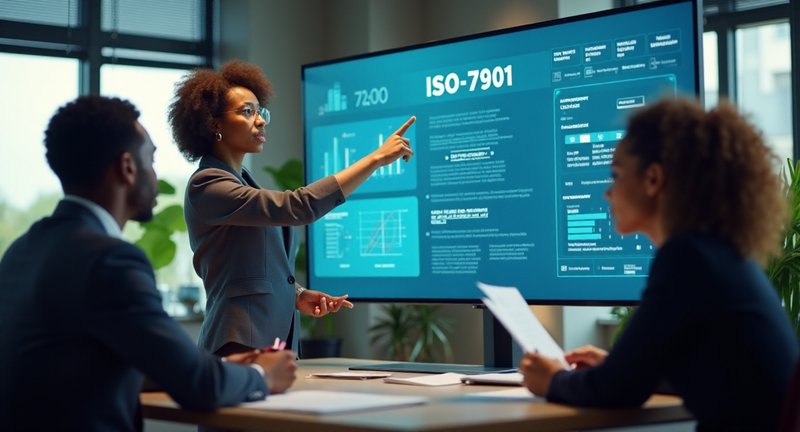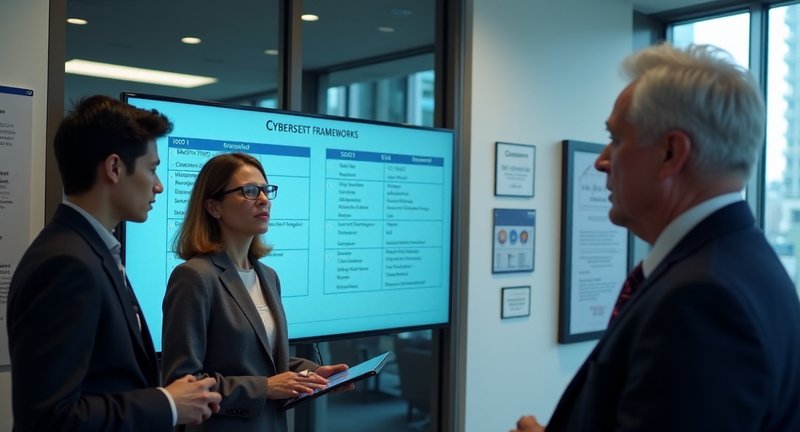Introduction to Iso 27001 Vs Soc 2
If you’re like many business owners, you’ve probably heard about information security standards, but what’s the real difference when comparing Iso 27001 vs Soc 2? Let me break it down for you.
On one hand, Iso 27001 is an international standard focused on establishing, implementing, and managing an Information Security Management System (ISMS). It’s comprehensive, giving you a full playbook on how to secure your company’s data. It’s like building a fortress around your information, ensuring you’re prepared for anything.

On the other hand, Soc 2 is more of a North American standard, primarily aimed at service providers. It focuses on the controls in place to protect your customers’ data, and while it’s more limited than Iso 27001, it’s designed with cloud service providers in mind. So, it’s not just about locking up your own data, but showing clients you’ve built a safe place for their information too.
Here’s a breakdown to simplify it:
-
Scope:
- Iso 27001: Company-wide, covering every department.
- Soc 2: Typically applies to service providers managing customer data.
-
Certification:
- Iso 27001: Requires formal certification.
- Soc 2: Attestation via an independent audit.
-
Purpose:
- Iso 27001: Security management.
- Soc 2: Customer trust.
Each has its merits, but it comes down to what suits your business best. If you’re thinking of securing operations globally, Iso 27001 could be your go-to. But if building trust with clients is your focus, then Soc 2 might align better.
ISO 27001 vs SOC 2: Which Security Framework is Best for You?
When you’re picking a security framework, it’s like choosing the right tool for a job. Both systems are designed to secure your data, but they come from different mindsets. The decision isn’t just about which is better, but rather, which one suits your business needs.
One framework offers a broad, international scope, providing a universal set of requirements. It’s great for organizations that operate across borders. The other is more tailored, with a focus on serving businesses that handle sensitive data, particularly in the cloud space.
From my experience, the right choice boils down to your client base and regulatory needs. If you’re dealing with global clients, you might want the structure that’s recognized worldwide. But, if you’re in the tech or SaaS sector, you’ll probably benefit from the more specialized approach.

Think of it as a question of scale. One is flexible, applicable across various industries, while the other hones in on the nitty-gritty of digital security. Both have value, but one might fit your industry’s specifics a bit better.
Whichever you choose, remember it’s about more than checking boxes. It’s about embedding a culture of security within your team, not just complying with standards. That’s where the real value of these frameworks shines through.
Understanding ISO 27001 and SOC 2 Compliance Standards
When you dive into the world of compliance, two names often float to the surface: ISO 27001 and SOC 2. Both are critical when it comes to safeguarding sensitive information, but they approach the issue from slightly different angles. Think of them as two distinct, yet complementary, pieces of the same puzzle.
ISO 27001 is like a blueprint for building a strong foundation in information security management. It’s a global standard that gives you a systematic approach to managing sensitive company data. From my experience, this is ideal when you need a comprehensive, overarching framework to cover all aspects of security – from physical safeguards to employee behavior.
On the other hand, SOC 2 is more laser-focused on the service provider-client relationship. It’s an audit report that helps companies show their customers that their data is handled with the utmost care. SOC 2 reports focus on trust service principles such as security, availability, processing integrity, confidentiality, and privacy. It’s tailored specifically for technology companies, particularly those in the SaaS world. If you’re ever negotiating deals with clients, SOC 2 is likely the name that will pop up more frequently.
Here’s a quick comparison to help make sense of their key differences:
-
Focus:
- ISO 27001: Comprehensive, company-wide information security.
- SOC 2: Focused on customer data handled by service providers.
-
Scope:
- ISO 27001: Applicable across various industries.
- SOC 2: Primarily relevant to tech and cloud-based services.
Also, choosing one (or both) depends on the nature of your business and your audience. Personally, I’ve found that aligning with both standards not only enhances trust but gives a competitive edge when expanding globally or working with security-conscious clients.
What is ISO 27001? An Overview
What is ISO 27001? Let me explain. It’s not just another dry acronym floating around the business world. ISO 27001 is an internationally recognized standard that focuses on how companies should manage their information security. It sets the rules for what we call an Information Security Management System (ISMS). Think of it as a framework a structured approach to keeping sensitive data under lock and key, but in a smart, adaptable way.
Let’s break it down. ISO 27001 is more than just policies it’s about embedding a culture of security within your organization. Here’s why it matters:
-
Risk Management: You can’t just cross your fingers and hope your data stays safe. ISO 27001 gives you a strategy to identify, assess, and mitigate risks. It’s a proactive rather than reactive approach.
-
Compliance: In a world full of regulations, following ISO 27001 helps ensure you’re meeting legal requirements. It’s like having an insurance policy for your business reputation.
-
Continuous Improvement: ISO 27001 isn’t a set-it-and-forget-it process. It demands regular reviews and updates, making sure your security keeps up with evolving threats. The system grows with you.
From my experience, implementing ISO 27001 can feel daunting at first, but the payoff is tremendous. It’s more than just ticking a box it’s about gaining trust, reducing risk, and positioning your business as a serious contender in today’s hyper-competitive market.
In short, ISO 27001 helps companies build a robust, adaptable shield around their most valuable asset information. Don’t underestimate the power of getting this right.
What is SOC 2? An Overview
SOC 2 – it’s more than just a standard, it’s a stamp of trust. Imagine you’re running a company that handles sensitive customer data. Now, how do you assure your clients their data is safe? That’s where SOC 2 comes into play.
SOC 2 isn’t just about ticking boxes. It’s a framework that focuses on how organizations manage their customer’s information, ensuring it’s safe from unauthorized access. This is especially crucial in today’s world where data breaches are making headlines left and right.
But here’s the real kicker – SOC 2 is flexible. Unlike other rigid certifications, SOC 2 is all about customization. It allows businesses to adapt the controls to their specific needs. It’s like getting a suit tailored just for you, rather than buying one off the rack.
The audit process, however, is no walk in the park. I’ve been through it, and I can tell you – it requires meticulous attention to detail. But the payoff? The trust of your customers, sealed with a certification that speaks volumes about your commitment to security.
Trust me, if you’re in the tech space or handling critical data, SOC 2 isn’t just a recommendation – it’s a necessity. And once you have it, it becomes a powerful tool in your business arsenal.
Key Differences Between ISO 27001 and SOC 2
When you’re looking at security frameworks, you’ll often see two big players thrown into the mix: ISO 27001 and SOC 2. Trust me, I’ve seen countless organizations get puzzled when trying to figure out which one is the right fit. So, let’s break it down from a different angle.
ISO 27001 is like the well-rounded safety net you put in place. It’s structured, comprehensive, and addresses a wide range of risks to protect information. It’s the go-to if you’re aiming to build an ironclad system that encompasses your entire organization.
SOC 2, on the other hand, is more of a deep dive into specific services. It’s all about the controls you have in place to ensure customer data stays secure. It doesn’t tackle everything; it focuses on a few essential trust principles that businesses need to prove they follow. It’s a precision tool, not a blanket strategy.
Now, one major difference lies in the intent. ISO 27001 is about creating and maintaining an ongoing, systematic approach to managing sensitive company information. Meanwhile, SOC 2 is more of an audit report that assures clients their data is in safe hands right here, right now.
The audience for each also varies. ISO 27001 tends to resonate with internal stakeholders and regulators, while SOC 2 is customer-facing, aimed at building trust. I’ve seen clients breathe a sigh of relief when they hear “SOC 2 compliant.”
So, whether you’re seeking a security culture overhaul or just trying to assure your customers, understanding the nuances of these two standards can make all the difference.
ISO 27001: Requirements and Benefits
Let me tell you, if you’re navigating the complex world of security standards, ISO 27001 is one of those frameworks you don’t want to miss. It’s not just another checkbox on your compliance list; it’s a full-blown system that can transform how you manage information security risks.
What are the core requirements?
At its heart, ISO 27001 demands an information security management system (ISMS), which is a formal set of policies, procedures, and controls. To get certified, you’ll need to address several key areas:
- Risk assessment: You’ll evaluate the risks to your organization’s information and prioritize them.
- Security policies: Crafting tailored policies that reflect your company’s specific needs.
- Leadership involvement: Top management must be involved, ensuring security is part of the business strategy.
- Ongoing improvement: It’s not a one-and-done constant monitoring and adaptation are required to stay compliant.
What are the real benefits?
Now, why go through all that effort? The benefits are substantial:
- Enhanced trust: Whether it’s your clients, partners, or employees, everyone feels more secure knowing their information is protected.
- Business growth: Some industries require ISO 27001 certification, so it can open doors to new contracts.
- Risk reduction: By systematically identifying and managing threats, you’ll lower the chance of data breaches or costly incidents.
- Legal compliance: Helps you meet regulatory requirements in multiple jurisdictions, avoiding fines and penalties.
So, it’s more than just about compliance it’s about embedding security into the DNA of your business.
SOC 2: Requirements and Benefits
With regard to navigating the labyrinthine world of data security, understanding SOC 2 requirements and benefits is crucial for any savvy business leader. I’ve witnessed firsthand how organizations grapple with these standards, and let me tell you getting a grip on them can elevate your trustworthiness in the eyes of clients and partners.
SOC 2 Requirements: What You Need to Know
- Security: You must have robust measures to protect client data against unauthorized access.
- Availability: Ensure that your systems are reliable and operational as promised.
- Processing Integrity: Your systems must operate without errors, ensuring that data is processed accurately.
- Confidentiality: Protect sensitive information to maintain privacy and integrity.
- Privacy: Safeguard personal data in accordance with your privacy policy.
Benefits of SOC 2 Certification
- Enhanced Credibility: Clients are more likely to trust a certified company. It’s like wearing a badge of honor in the digital realm.
- Competitive Advantage: Stand out from the crowd SOC 2 certification can be a game changer in a saturated market.
- Risk Mitigation: Identifying and addressing security gaps can prevent costly breaches and foster a culture of proactive management.
- Client Confidence: Show your customers that you take their data seriously, creating a loyal following that appreciates your diligence.
In the great debate of “ISO 27001 vs SOC 2,” remember that while both standards have their merits, they serve different purposes and audiences. SOC 2 focuses more on service organizations, whereas ISO 27001 provides a broader framework applicable across various sectors. Choosing between them depends on your specific business needs and the level of assurance you wish to provide.
The Essentials of ISO 27001 vs SOC 2
Navigating the world of information security standards can feel like wandering through a dense forest. You’ve got two prominent paths to explore, each with its unique scenery and challenges.
On one hand, we have the globally recognized framework that sets the bar for managing sensitive data. This framework is all about establishing a systematic approach to security risks, ensuring that organizations can protect their information assets effectively. Imagine having a trusty map that guides you through potential pitfalls; that’s the essence of this framework.
Then, we have the other path, tailored more towards service organizations. This framework focuses on how these entities safeguard customer data and the operational effectiveness of their controls. It’s like having a reliable compass that helps you navigate the trustworthiness of a service provider.

While both paths lead to improved security posture, their focal points differ. The first emphasizes a comprehensive security management system, whereas the second highlights specific controls related to data privacy and security. Think of it as choosing between a detailed guidebook and a practical checklist.
In my experience, understanding these two distinct yet complementary approaches has been invaluable. They not only help in compliance but also build a culture of trust and transparency within organizations.
Also, whether you’re drawn to the structured framework or the service-oriented approach, embracing these standards can empower your organization to thrive in a digital world rife with risks.
How ISO 27001 and SOC 2 Address Data Security
In today’s digital landscape, safeguarding data has become an essential pursuit. My journey into the world of data security introduced me to two heavyweight champions: ISO 27001 and SOC 2. Each offers a unique approach to addressing the ever-looming threat of data breaches.
ISO 27001 is like a meticulous blueprint for establishing an Information Security Management System (ISMS). It lays out comprehensive requirements that guide organizations in identifying and mitigating risks. Think of it as setting the stage for a grand performance where every detail matters.
On the flip side, SOC 2 dances to a different rhythm. It focuses on the controls relevant to data protection based on the Trust Services Criteria. When I first encountered SOC 2, it felt like a warm embrace, providing a framework that emphasizes accountability and transparency.
In my experience, ISO 27001 thrives on documentation and rigorous audits. It’s as if you’re crafting a symphony where each note must align perfectly. This meticulousness can feel overwhelming, but it ensures a solid foundation for security practices.
Conversely, SOC 2 feels more dynamic and adaptable. It encourages organizations to regularly assess their security posture, making it easier to adjust to the fast-paced nature of technology. This flexibility resonated with me as I navigated the rapidly changing digital waters.
Also, both frameworks are invaluable allies in the quest for data security. They complement each other beautifully, offering a holistic view of how to protect sensitive information. So, whether you lean toward the structure of ISO 27001 or the agility of SOC 2, remember that the goal is the same: creating a fortress around your data.
Compliance Scope: ISO 27001 vs. SOC 2
When diving into the world of compliance frameworks, it’s fascinating to see how each serves its unique purpose. Take ISO 27001, for instance; it’s like the sturdy fortress of information security management. I’ve seen organizations thrive by establishing a comprehensive approach to safeguarding data.
On the flip side, SOC 2 feels more like a nuanced dance, focusing on service organizations’ operational practices. In my experience, the emphasis on trust and transparency is palpable, especially when clients seek assurance about how their data is handled.
Both frameworks beckon companies to examine their processes, but they do so from different vantage points. ISO 27001 requires a systematic, risk-based approach, while SOC 2 zeroes in on specific trust service criteria, like security and confidentiality.
For a business leader, understanding these differences can be a game changer. It’s about choosing the right path that aligns with your organization’s goals and customer expectations.
Navigating this compliance landscape is essential for building a robust reputation. Trust me, investing time in understanding these frameworks not only mitigates risks but also enhances your credibility in a competitive market.
So, whether you lean towards the fortress of ISO or the fluidity of SOC 2, remember that each framework carries its own weight in the grand context of compliance. Embrace the journey, and let it guide you toward a more secure and transparent future.
Certification Processes: ISO 27001 and SOC 2
With regard to navigating the tricky waters of certification in the world of data security, two heavyweights stand out: ISO 27001 and SOC 2. If you’re serious about protecting sensitive information and building trust with clients, these frameworks are likely on your radar. But let’s break it down without the jargon overload.
ISO 27001 is like the Swiss Army knife of security certifications. It covers everything physical, digital, procedural. The standard outlines a systematic approach to managing sensitive company information, ensuring it stays safe, intact, and available when needed. It’s not just for tech giants either; any organization can implement this to streamline their data protection practices.
SOC 2, on the other hand, has a laser focus on service providers that manage data in the cloud. Think of it as the watchdog for cloud-based operations, ensuring that customer data is handled with integrity, availability, and security in mind. It’s an audit-driven process, meaning independent third-party auditors come in to assess your compliance. You’ll have to prove you’ve got the proper safeguards in place across five core principles: Security, Availability, Processing Integrity, Confidentiality, and Privacy.
Here’s a quick way to look at the main differences:
-
Focus areas:
- ISO 27001 looks at your whole organization’s information security.
- SOC 2 is zeroed in on service providers managing data.
-
Implementation:
- ISO 27001 is an internal playbook, requiring thorough documentation and ongoing improvements.
- SOC 2 is more audit-based, with emphasis on the actual practices you implement for customer data.
In my experience, both certifications can seem daunting, but they’re worth every bit of the effort. Not only do they help you sleep better at night, knowing your systems are secure, but they also send a powerful signal to your clients: “We take your data seriously.”
Cost and Time Comparison for ISO 27001 and SOC 2 Compliance
When it comes to compliance, navigating the maze of costs and timelines can feel like trying to read a map in a foreign language. In my journey, I found that both ISO 27001 and SOC 2 compliance come with their own unique price tags and timelines, which can be quite the conundrum.
Let’s kick things off with costs. Implementing ISO 27001 typically involves a hefty initial investment. Think training, documentation, and the implementation of controls. On the flip side, SOC 2 might be more budget-friendly upfront, but watch out for those hidden costs that can creep up, especially during audits.
Now, let’s talk time. Achieving ISO 27001 certification isn’t a sprint; it’s more of a marathon. I’ve seen organizations take anywhere from several months to over a year to complete the process. Meanwhile, SOC 2 can often be wrapped up in a fraction of that time, especially if you’re already following some best practices.
However, don’t be fooled by the speed of SOC 2. The intensity of the audit process can add pressure, turning the experience into a high-stakes game. As someone who’s been through the trenches, I can assure you that every minute counts, and careful planning is essential.
In the end, whether you choose the longer road with ISO or the faster lane with SOC 2, it’s all about what fits your organization’s needs. Weigh those costs and timelines wisely, and you’ll find your way through the compliance jungle.
Which Standard is Better for Your Business?
Choosing the right standard for your business’s security needs can feel like standing at a crossroads. Each path promises protection, but which one leads to where you need to go? Here’s the thing deciding what’s best for your company boils down to your unique goals, industry demands, and client expectations.
Let’s break it down into key factors you should consider:
-
Regulatory requirements: Are you in an industry that faces strict regulations? Certain certifications may align better with compliance needs, especially if you’re handling sensitive financial or healthcare data. Make sure the standard you choose will satisfy auditors and regulators without extra headaches.
-
Client demands: I’ve seen it many times clients love when businesses speak their language. If your clients are more familiar with a particular standard, it might make sense to choose the one that offers them peace of mind. Trust is built by meeting expectations, especially in security.
-
Global vs. Local Reach: Is your business primarily operating internationally or regionally? Some frameworks are recognized and valued globally, while others may offer stronger credibility in local markets. Understanding where your key markets lie helps you pick the certification that packs more punch.
-
Implementation Costs and Resources: Let’s be real cost is always a factor. Some frameworks are heavier on resources and require a deeper investment in terms of time, personnel, and capital. Consider what’s feasible for your team without compromising security integrity.
Whichever road you take, remember: The choice isn’t just about meeting a requirement. It’s about ensuring your business thrives securely, and sometimes, that means choosing the framework that fits your culture as much as your industry.
Industry-Specific Compliance Needs: ISO 27001 vs. SOC 2
Navigating the world of industry compliance can feel like a balancing act. Different sectors demand different kinds of frameworks, and while they often overlap, each one brings its own quirks to the table. I’ve worked with organizations that needed to make the right call between certifications geared towards protecting data and let me tell you, there’s a lot to unpack.
For instance, a technology firm that deals with software-as-a-service (SaaS) is going to have very different compliance needs compared to, say, a financial institution. Why? Well, because the nature of their risks differs. SaaS companies tend to focus on securing their cloud-based platforms and user data, while banks are heavily regulated to ensure financial and customer security at all levels.
Here’s where compliance standards can get tricky:
- Different Focus: One set of guidelines might zero in on the security of information systems, while others assess how well an organization protects customer data and privacy.
- Industry Relevance: Are you a healthcare provider? Your focus will naturally skew towards protecting sensitive patient records. On the flip side, tech companies might lean more on frameworks that prioritize data encryption, storage, and transmission security.
- Assessment Types: Some frameworks involve external audits that drill deep into both your processes and the tech infrastructure, whereas others allow for internal assessments that might be a better fit for a growing startup.
When I advise clients, I emphasize that no certification is a one-size-fits-all solution. They need to align their compliance goals with the actual risks they face in their specific industry. Also, the choice between frameworks will depend on where your vulnerabilities lie and what your customers expect.
Need More Info?
What is the difference between ISO 27001 and SOC 2 mapping spreadsheet?
The ISO 27001 and SOC 2 mapping spreadsheet helps organizations compare the requirements of these two frameworks. ISO 27001 is an international standard focusing on Information Security Management Systems (ISMS), while SOC 2 is a U.S.-based auditing standard aimed at ensuring service providers manage data securely. The mapping spreadsheet identifies overlaps and gaps between the two, making it easier for organizations to comply with both frameworks simultaneously. This tool is particularly useful for companies operating internationally and in sectors where both standards are relevant.
What is the SOC 2 equivalent in Europe?
The European equivalent of SOC 2 is generally considered to be ISO 27001. While SOC 2 focuses on service organization controls around data security, availability, and privacy, ISO 27001 provides a comprehensive framework for establishing, implementing, maintaining, and continually improving an information security management system (ISMS). ISO 27001 has wider global recognition and is often used by European organizations, especially those looking for international certification and compliance with data protection regulations such as the GDPR.
Which SOC report is closest to an ISO report?
The SOC 2 Type II report is considered closest to an ISO 27001 certification. Both SOC 2 Type II and ISO 27001 focus on continuous monitoring and management of security controls, emphasizing operational effectiveness over time. SOC 2 Type II requires an auditor to evaluate a service organization’s controls over a period, similar to ISO 27001’s emphasis on maintaining an information security management system (ISMS) that is audited regularly. The overlap in controls and the focus on security management make these reports comparable.
What is the difference between ISO 27001 Stage 1 and Stage 2?
ISO 27001 certification involves two stages. Stage 1 is the initial review, where the auditor assesses whether an organization’s Information Security Management System (ISMS) has been developed according to the standard’s requirements. It focuses on document review, scope, and readiness for a full audit. Stage 2 is a more in-depth evaluation where the auditor checks the implementation and effectiveness of the ISMS in practice. It involves a detailed audit of processes, policies, and controls to ensure compliance and that the system is functioning as intended.
Is ISO 27001 equivalent to SOC 2?
No, ISO 27001 is not equivalent to SOC 2, but both serve similar purposes regarding information security. ISO 27001 is an international standard for establishing and maintaining an Information Security Management System (ISMS), while SOC 2 is an auditing standard used primarily in the United States to evaluate service providers’ data security practices. Although they both focus on data security, ISO 27001 is broader in scope and internationally recognized, whereas SOC 2 is more narrowly focused on service organizations’ specific control areas, particularly in the U.S. market.
What are the differences between ISO and SOC?
ISO, particularly ISO 27001, is an international standard that provides a framework for an organization to establish, implement, maintain, and continually improve an Information Security Management System (ISMS). SOC (Service Organization Control), particularly SOC 2, is a U.S.-based audit standard designed to assess service providers’ controls around data security, availability, and privacy. ISO 27001 is recognized globally, while SOC reports are more regionally focused on the U.S. The key difference lies in the scope ISO focuses on the management system, while SOC evaluates control effectiveness in specific areas.
What is the international equivalent of SOC 2?
The international equivalent of SOC 2 is ISO 27001. While SOC 2 focuses on the security, availability, processing integrity, confidentiality, and privacy of customer data for U.S. service organizations, ISO 27001 offers a global framework for managing information security through an Information Security Management System (ISMS). Organizations outside of the U.S., especially in Europe, often opt for ISO 27001 to demonstrate compliance with international security standards, as it is recognized and accepted worldwide.
What is another name for SOC 2?
SOC 2 is often referred to as a ‘Service Organization Control 2 report.’ It is also sometimes simply called a “SOC 2 audit” or “SOC 2 certification,” though technically, it is not a certification but rather an audit report that evaluates the effectiveness of an organization’s controls over security, availability, and privacy. These terms are used interchangeably, particularly in discussions related to third-party risk management and data protection.
What is the difference between SOC for cybersecurity and SOC 2?
SOC for Cybersecurity and SOC 2 are both audit reports, but they serve different purposes. SOC 2 evaluates a service organization’s controls over data security, availability, processing integrity, confidentiality, and privacy, with a focus on managing data for specific services provided to clients. SOC for Cybersecurity, on the other hand, is designed to assess an organization’s overall cybersecurity risk management program, providing stakeholders with assurance about the organization’s ability to detect, respond to, and recover from cyber threats. SOC for Cybersecurity is broader in its focus on risk management.
What is the difference between NIST 800 53 and ISO 27001 mapping?
NIST 800-53 and ISO 27001 mapping involves comparing two distinct security frameworks. NIST 800-53 is a U.S. federal government standard focused on security and privacy controls for federal information systems, with a heavy emphasis on technical and operational controls. ISO 27001, however, is an international standard that provides a framework for establishing an Information Security Management System (ISMS) covering a broad range of information security controls. Mapping between the two helps organizations bridge the gap between international information security management practices and specific regulatory requirements in the U.S.
What is the difference between NIST framework and SOC 2?
The NIST framework (particularly the NIST Cybersecurity Framework) is a voluntary guideline primarily used by U.S. organizations to manage and mitigate cybersecurity risks. It focuses on five key functions: Identify, Protect, Detect, Respond, and Recover. SOC 2, on the other hand, is an auditing standard that evaluates a service organization’s control environment, specifically regarding data security, availability, processing integrity, confidentiality, and privacy. The NIST framework is broader in its application, whereas SOC 2 is more focused on service organizations providing customer-facing data services.











I really appreciate how you broke down the differences between ISO 27001 and SOC 2. It’s clear that each has its unique strengths. Personally, I think the comprehensive nature of ISO 27001 is fantastic for larger organizations that need to cover all bases, while SOC 2 really shines in tech environments. It’s like choosing between a Swiss Army knife and a scalpel both are useful, but in different ways!